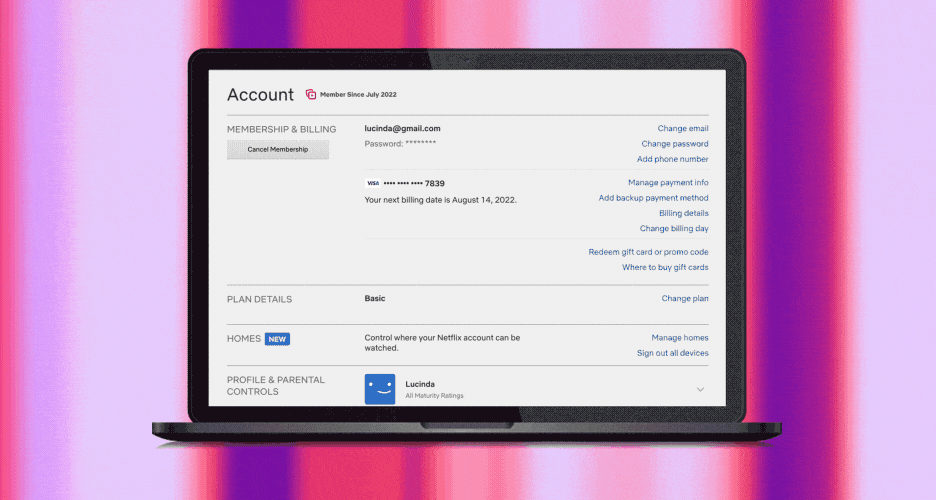Netflix is testing a new way to tackle password sharing in Argentina, El Salvador, Guatemala, Honduras, and the Dominican Republic (as reported first by Bloomberg). A support page for Netflix in Honduras clearly states the test will prompt users to pay an additional fee if they use an account on a TV or TV-connected device at a location outside their primary household for over two weeks. Each additional home will cost an extra 219 pesos per month, per home in Argentina ($1.17 US), and $2.99 everywhere else.
According to Netflix, in the test areas, subscriber accounts have one primary “home” where they can access Netflix across any devices in the home, as well as travel and use Netflix on laptops and mobile devices elsewhere without the extra step. The test will allow users to purchase additional “homes,” which they choose to add or skip to use the service on TV screens.
The support page explains the process:
Add an extra home
Beginning August 22, 2022, when you sign in to Netflix on a TV outside of your home, you will see the option to add the extra home for an additional fee per month.
If you will only be using this TV for a limited time, you can watch Netflix for up to 2 weeks at no extra charge as long your account has not been previously used in that location. After that time, the TV will be blocked unless you add the extra home.
The support pages also go into more detail about how Netflix determines a “home,” defined as “a physical location – like your house – where you can use your Netflix on any of your devices.”
Further down the page, it explains what Netflix does to detect use at a different “home.”
How Netflix detects homes
We use information such as IP addresses, device IDs, and account activity.
If you are using a device within your included home and still see a message that says that too many homes are using your account, you can:
Make sure that the device is connected to the same internet connection as the other devices in the home.
Make sure that the device is not connected to a VPN, proxy, or any unblocker service.
Netflix explains that your use of Netflix on a TV outside your home while “traveling” is eligible without an extra charge for up to two weeks, “as long as your account has not been previously used in that location. This is allowed once per location per year.”
In these countries, Netflix is also working on a feature that will let you track where your account is being used and restrict access. If you’re on the Basic plan, you can add one extra home, if you’re on the Standard plan, you can add up to two, and on Premium, you can add up to three.
“It’s great that our members love Netflix movies and TV shows so much they want to share them more broadly,” Chengyi Long, Netflix’s director of product innovation, said in a statement. “But today’s widespread account sharing between households undermines our long term ability to invest in and improve our service.”
This expands on Netflix’s existing test that pushes subscribers in Costa Rica, Peru, and Colombia to pay extra for users living outside their households. Netflix is currently charging users an extra 2,380 CLP ($2.52 USD) in Chile, $2.99 USD in Costa Rica, and 7.9 PEN ($2.02 USD) in Peru to add up to two additional “subaccounts” to an existing account. The company also started experimenting with a profile transfer tool that’s supposed to make it easier for someone to transfer their recommendations, watch history, and My List. This is a way for the platform to passively nudge password sharers toward opening a new account or getting on a subaccount.
In May, a report from Rest of World revealed confusion among subscribers who are part of the test in Peru. Some subscribers were reportedly unsure about Netflix’s definition of a “household,” while others were able to get around a prompt meant to validate account owners.
Netflix first announced it would be testing ways to charge for password sharing in March, just a few weeks after it announced price increases for US customers. Netflix is also working on an ad-supported subscription option and, just last week, said it would partner with Microsoft to power its advertisements. The company has clear reasons to look for new ways to generate revenue; in April, after a subscriber boom earlier in the pandemic, it announced in April that it had lost subscribers for the first time in more than a decade. The company’s next quarterly earnings report will be released on Tuesday afternoon.
Update July 18th, 7:30PM ET: Added additional information from Netflix’s Support pages about how the options work, that it appears for users signing in on a TV or TV-connected device, how Netflix defines a “home,” and what information Netflix tracks to detect where and how subscribers are using the service.
Disclosure: The Verge recently produced a series with Netflix.

